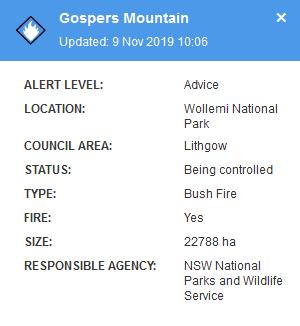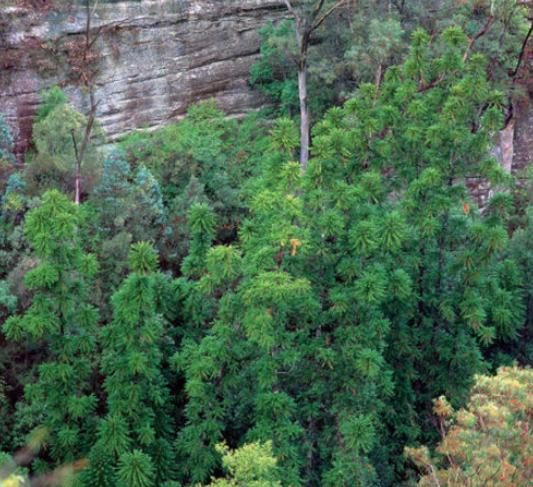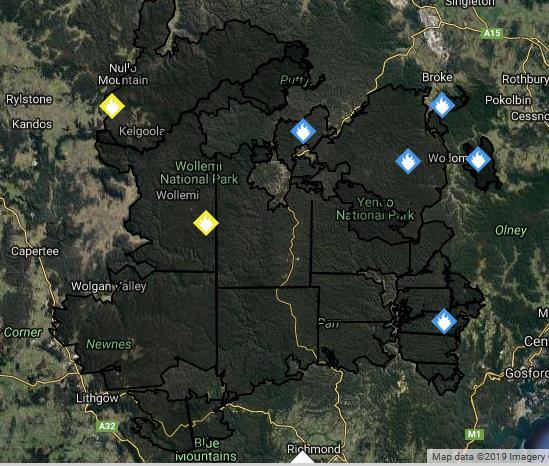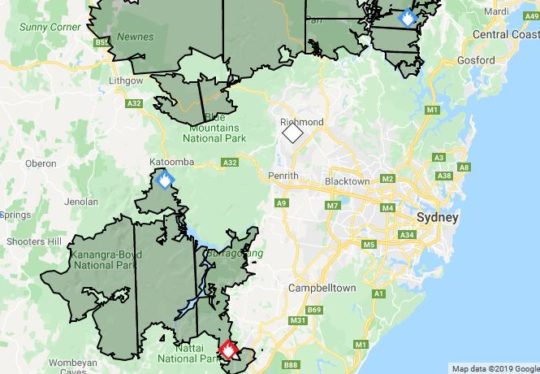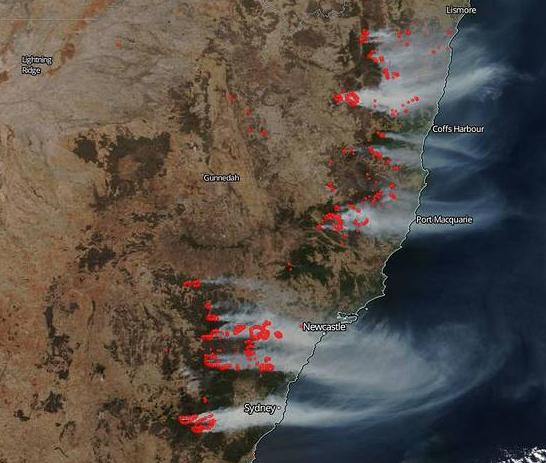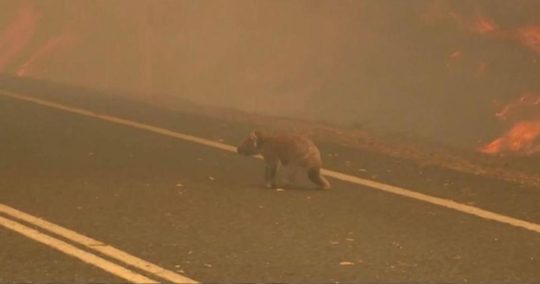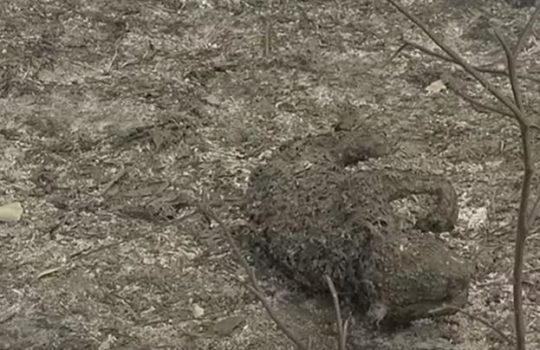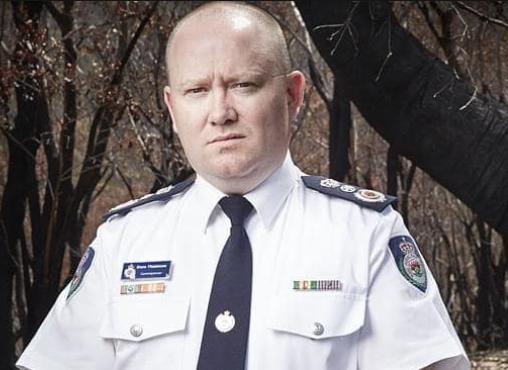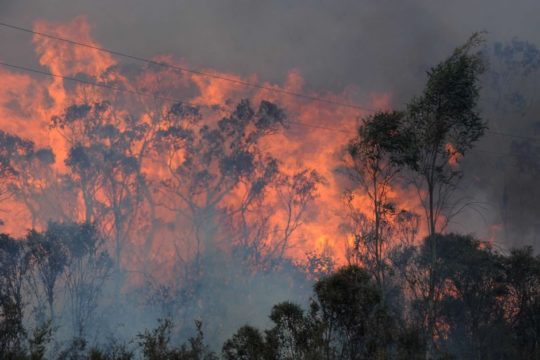Cradle of Conservation left to incinerate, again
Wednesday, January 22nd, 2020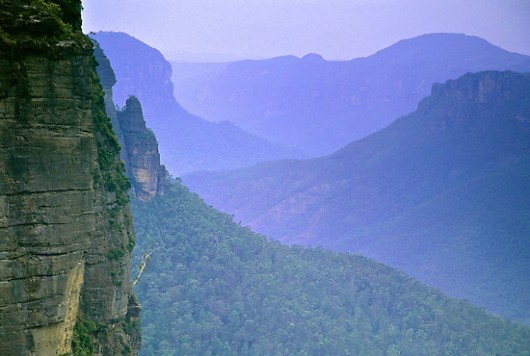 Pre-2006: The Grose Valley’s 500m+ deep upper Grose Gorge displayed a Blue Mountains profile of sandstone cliffs above talus thickly carpeted by Eucalypt forest supporting rich diversity in plantlife, wildlife, birdlife, creeklife and buglife – just an eco-happy cradle of conservation.
Pre-2006: The Grose Valley’s 500m+ deep upper Grose Gorge displayed a Blue Mountains profile of sandstone cliffs above talus thickly carpeted by Eucalypt forest supporting rich diversity in plantlife, wildlife, birdlife, creeklife and buglife – just an eco-happy cradle of conservation.
(NB: This photo shows Eucy-mist, not Eucy-smoke. – Ed.)
In 1926, developer Ernest Williamson famously described the Blue Gum Forest in the heart of Grose Valley in the Blue Mountains thus:
“… a flat, unsurpassed on the mountains for the beauty and grandeur of its trees! Magnificent blue gums, straight and towering skyward in great heights … they appear like the huge pillars of a mountain temple.”
Ernest went on to more infamously propose:
“the Valley of the Grose could, in a few years, be transformed from a riot of scrubland to a hive of industry conveniently situated at what has been aptly described ‘the back door of Sydney’”.
According to Blue Mountains historian and author, Andy Macqueen, Williamson’s property development outfit calling itself The Grose Valley Development Syndicate, proposed in the 1920s or the Grose Valley’s forests to be deforested for timber exploitation and that a shale coal mine and coal-fired power station be built there. It would be an industrialised Lithgow Mark II. Other threats to the Blue Gum Forest included a proposed railway line and a dam. So why not a tannery and nuclear waste dump to boot?
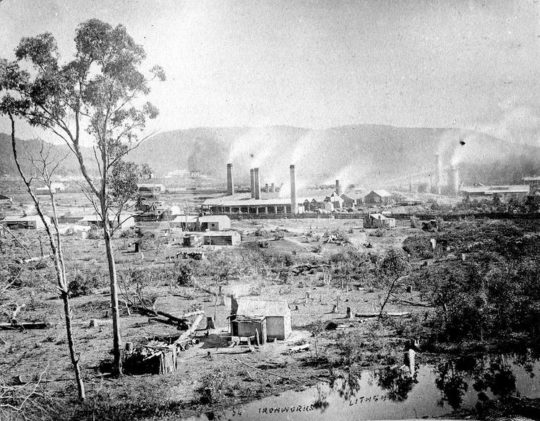 Grose Valley Vision Splendid? – a gross Lithgow industrial vision…note the few remnant token gums retained for ambience, or was it just slack ‘clearing’.
Grose Valley Vision Splendid? – a gross Lithgow industrial vision…note the few remnant token gums retained for ambience, or was it just slack ‘clearing’.
Blue Gum Forest – Australia’s Cradle of Conservation
For generations since the 1920s, conservationists have posited somewhat a more respectful plan for the Grose Valley than by Ernest Williamson and his robber-barons. The plan being to respect and conserve the ecological values and the anthropocentric aesthetic ‘eye-candy’ tourist benefits of the Grose Valley.
Since 1875, the Blue Gum Forest was the scene of an artists’ camp established by Frederick Eccleston Du Faur of the Academy of Art. Since then, conservationists have lobbied to protect the Grose Valley from “alienation” – read ruination.
In 1931, during an Easter hiking trip, a group of bushwalkers from the Mountain Trails Club and the Sydney Bush Walkers club, led by Alan Rigby, camped in the Blue Gum Forest.
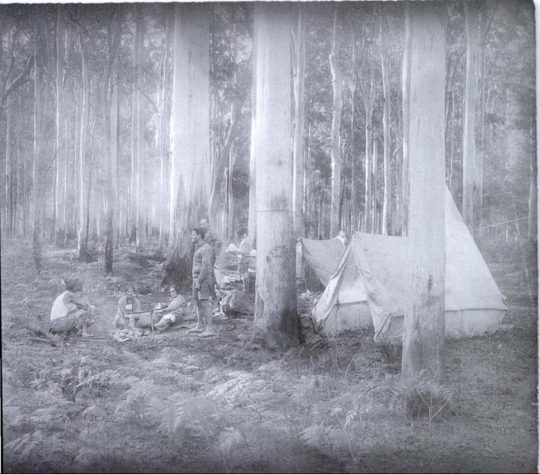 Since 1931 the Blue Gum Forest has been ecologically recognised and presumed protected.
Since 1931 the Blue Gum Forest has been ecologically recognised and presumed protected.
[Source: Myles Dunphy Collection, Mitchell Library in the State Library of New South Wales, Sydney.]
While the bushwalkers camped, an orchard farmer of Bilpin, Clarence Hungerford, rode in on his horse to confront the bushwalkers ‘squatting’ on his property. Hungerford had secured a lease of the forest to graze his cattle. Hungerford told to the hikers that he intended to deforest all the blue gums and to sell the timber in order to finance a walnut orchard.
 Blue Gum Forest – flagged for deforestation in 1931 for Hungerford’s walnut orchard ‘vision splendid‘
Blue Gum Forest – flagged for deforestation in 1931 for Hungerford’s walnut orchard ‘vision splendid‘
The bushwalkers’ Hungerford experience didn’t go down well. Incensed and horrified, the bushwalkers immediately started a campaign to stop Hungerford’s decimation of the Blue Gum sanctuary. Their impassioned rallying ultimately raised £130; quite a substantial sum in the depth of the Great Depression. They then paid all the funds to Hungerford in exchange for his undertaking to relinquish his pastoral lease of the Blue Gum Forest.
The bushwalkers met with Hungerford at the Blue Gum Forest on 15 November 1931 in pouring rain, and he agreed with their suggestion. Most of the funding had been donated by James Cleary, then head of the NSW railways, a keen bushwalker and conservationist. One of the key activists in the campaign was Myles Dunphy, who at the time was developing his plans for the Blue Mountains National Park.
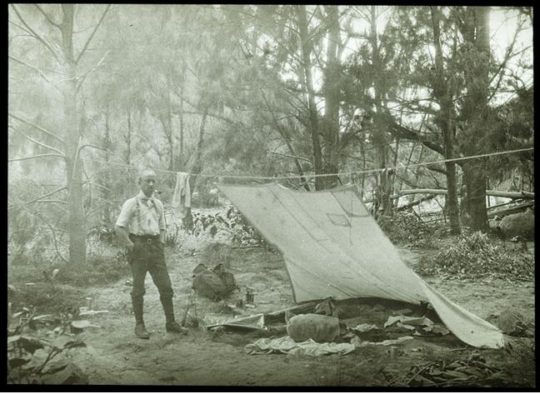 “We hold our land in trust for our successors.” (1934) – Myles Joseph Dunphy (1891-1985), architect, legendary long distance wilderness trekker, map maker, and conservationist before his time. Dunphy always took his Lee Enfield .303 with him for hunting for food when trekking, like on this occasion – it’s under wraps under the tent fly. A daily twilight roo kill for protein was the secret behind him managing to trek his incredible distances. Born on 19 October 1891 in South Melbourne, eldest of seven children… [Read More]
“We hold our land in trust for our successors.” (1934) – Myles Joseph Dunphy (1891-1985), architect, legendary long distance wilderness trekker, map maker, and conservationist before his time. Dunphy always took his Lee Enfield .303 with him for hunting for food when trekking, like on this occasion – it’s under wraps under the tent fly. A daily twilight roo kill for protein was the secret behind him managing to trek his incredible distances. Born on 19 October 1891 in South Melbourne, eldest of seven children… [Read More]
Hungerford’s horse track became a developer tribute to Hungerford. The contour-following bush track starts about 300m south of Evans Lookout and descends zig-zagging down the escarpment to the flats of the Grose Valley at Govetts Creek. In its ignorance, the NPWS or more aptly, the Tourist Parks Service, named this track ‘The Horse Walking Track’ – for visitors to walk their horses?
The Blue Gum Forest has since been referred to in the conservation movement as the Cradle of Conservation for it was the focus of Australia’s original ecological protection by a small group of “thoughtful, committed citizens” (Margaret Mead quote extract) and which seeded generations later, the international listing of The Greater Blue Mountains World Heritage Area in 2000. What legends!
 Blue Gum Forest survives only as photos, posters and memories. [Source: ‘Blue Gum Forest 18-19 October 2014‘, 20141022, © by Dave Noble, ^http://www.david-noble.net/blog/?p=6001.]
Blue Gum Forest survives only as photos, posters and memories. [Source: ‘Blue Gum Forest 18-19 October 2014‘, 20141022, © by Dave Noble, ^http://www.david-noble.net/blog/?p=6001.]
David Noble is the parks ranger who discovered Wollemi Pine (Wollemia nobilis) in 1994. In September 2012, Noble revisited the Blue Gum Forest leading a hike to celebrate eighty years since the Blue Gum Forest was saved on 2nd September 1932.
Dave wrote at the time:
“This majestic forest lies at the intersection of the Grose River and Govetts Creek near Blackheath. Back in 1932, a large portion of the forest (it was then private land) was going to be felled and replaced by walnut trees. Visiting bushwalkers were alarmed, and rallied together and ended up raising money to purchase the block in question and saving it for conservation. Many regard this as the start of the conservation movement in NSW.”
[Source: ‘Blue Gum Forest – 80th Anniversary 1-2 September 2012‘, 20120913, by Dave Noble, ^http://www.david-noble.net/blog/?p=1846]
But conservationist idealism ignored the arsonist culture. Government baby boomer arsonists have had a view of native Eucalypt forests like the Blue Gum not as cherished ecology but as a valueless hazard, just like Williamson, generations before. The New South Wales Government ‘autorities’ have been chafing at the bit for years to hazard reduce Blue Mountains World Heritage “fuel“.
History of Neglectful Arson
In December 1957, a bushfire that was left to burn in bushland east of the Grose Valley, once the wind picked up, ultimately ripped through the timber clad villages of Leura and Wentworth Falls destroying 170 homes.
In December 1976, 65,000 hectares of Blue Mountains native bushland was burnt. A year later, a bushfire burnt out 49 buildings and another 54,000 hectares of Blue Mountains native bushland.
In summer 1982 a bushfire burnt right through the Grose Valley incinerating 35,000 hectares of tall native forest, and wildlife.
Again in 1994 the Grose Valley was let burnt by bushfire.
Grose Valley Arson in November 2006
Again in November 2006 the RFS backburned into the Grose Valley from Hartley Vale. Ignited by Rural Fire Service along the north side of Hartley Vale Road on a day of Total Fire Ban, bush arson incinerated native forest ecology up the length of Hartley Valley Road and then was allowed to spot over the Darling Causeway let descend into the Grose Valley. It was deliberate bush arson sanctioned by the NSW Government under then RFS Commissioner Mal Cronstedt at the time.
The fire was fanned by westerly winds over days, allowed to cross over the Darling Causeway, merge with the Burra Korain wildfire and descend down Perrys Lookdown hiking track in and through the Blue Gum Forest. Many Blue Mountains residents will be well familiar with this infamous photo of the Grose Pyrocumulus (flammagenitus) cloud rising from the Grose Valley on Thursday afternoon 23rd November 2006.
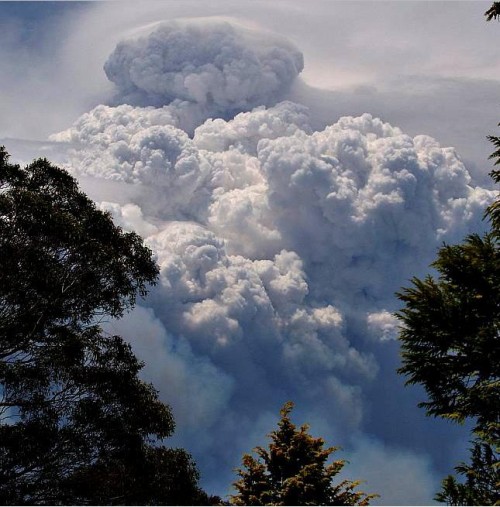 Grose Valley incineration of 2006. [Source: ‘2006 Grose Fires – the realisation of a tragedy, 20070707, The Habitat Advocate, >https://www.habitatadvocate.com.au/2006-grose-fires-the-realisation-of-a-tragedy/]
Grose Valley incineration of 2006. [Source: ‘2006 Grose Fires – the realisation of a tragedy, 20070707, The Habitat Advocate, >https://www.habitatadvocate.com.au/2006-grose-fires-the-realisation-of-a-tragedy/]
At the time there was local community outrage about how the precious Blue Gum Forest was not defended by authorities and allowed to be incinerated. Blue Mountains resident meetings were staged and a full page article was published in the Blue Mountains Gazette newspaper entitled >’Burning Issues – Fire in the Grose Valley (a statement funded and supported by concerned residents‘. It would have cost at least $2000. Community meetings were held, arranged by former parks ranger Ian Brown. But then it got political and the campaign was strangely suddenly aborted.
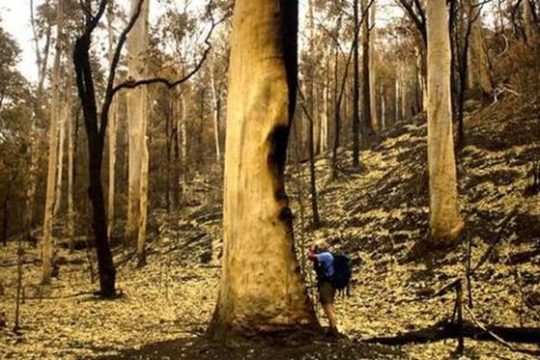 Blue Gum Forest burnt in 2006 by an RFS hazard reduction. [Source: Photo by Nick Moir of Blue Mountains Botanist Dr Wyn Jones inspecting the fire damage to the Blue Gums, dated 2006122 in the Sydney Morning Herald, >https://www.habitatadvocate.com.au/2006-grose-valley-fire-a-cover-up/]
Blue Gum Forest burnt in 2006 by an RFS hazard reduction. [Source: Photo by Nick Moir of Blue Mountains Botanist Dr Wyn Jones inspecting the fire damage to the Blue Gums, dated 2006122 in the Sydney Morning Herald, >https://www.habitatadvocate.com.au/2006-grose-valley-fire-a-cover-up/]
Grose Valley Arson of December 2019
Then Last month in December 2019 the government Baby Boomer arsonists ultimately had their way. On 16th December, the Gospers Mountain Fire crossed the Bells Line of Road and spotted into the Grose Valley. By 21st December the Blue Gum Forest was gone.
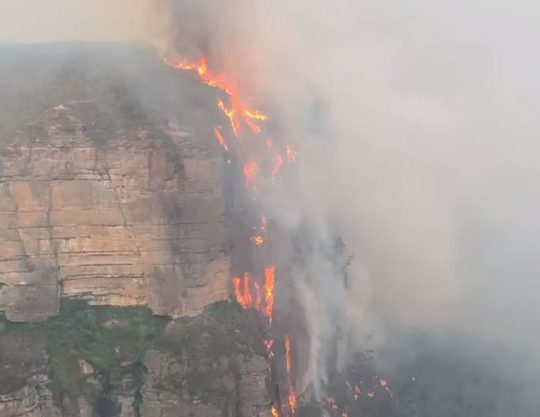 Media warped termed ‘lava waterfall‘ up the Blackheath escarpment in the Grose Valley.
Media warped termed ‘lava waterfall‘ up the Blackheath escarpment in the Grose Valley.
[Source: Saturday 20121221, ^https://www.facebook.com/BlueMountainsExplore/]
Months prior, a remote rural pastoral property near Gospers Mountain somehow within the Wollemi Wilderness, created an ignition on Saturday 26th October 2019.
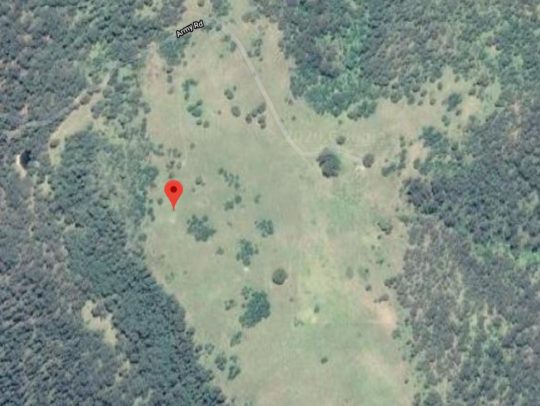 Gospers Mountain showing remote historic rural cattle paddocks deep within the Wollemi Wilderness. The Australian Government calls it a national park but takes no accountability by delegating custodial protection but no funding to the state government of New South Wales.
Gospers Mountain showing remote historic rural cattle paddocks deep within the Wollemi Wilderness. The Australian Government calls it a national park but takes no accountability by delegating custodial protection but no funding to the state government of New South Wales.
Gospers Mountain is 50km NE of the locality of Bell as the crow flies or fire spreads. Officially declared started by dry lighting in the ‘national park’ on a hot Saturday, this crime of arson and subsequent government firefighting neglect remains secretive. So NSW Police Bush Arson Squad ‘Strike Force Toronto‘ where are you on this – honest or corrupted by the Premier and RFS?
The RFS Gospers Mountain Fire has been the largest bushfire in New South Wales state history. The total number of days between Saturday, October 26th, 2019 and Monday, December 16th, 2019 was 51 days; or one month and 20 days. Over 51 days the fire was allowed to become a ‘megafire’ (likely a new Macquarie Dictionary term for 2020) and ultimately the largest single bushfire in Australia’s history – incineratingmore than 500,000 hectares of bush wilderness…
Of course the Gospers Mountains Fire was left to spread into a mega-fire and to cross over the Bells Line of Road some 50km south-west.
So what did the RFS do for PR but rebrand the Gospers Mountains Fire southerly spread as a new Grose Valley Fire, and to so to be allowed to incinerate down the escarpment into the Grose Valley and to incinerate the Cradle of Conservation – the Blue Gum Forest.
As if RFS arsonists care a damn?
Now government paid white collar fire chiefs have had their way. Forest incineration complete. Easy-peasy till retirement.
Yes RFS let an ignition with a small plume of smoke rising in remote National Park inaccessible to fire trucks burn neglected for days and weeks, negligent of the consequences. What hazard predictably eventuates when ignored for weeks? From the RFS ignition detected at Gospers Mountain on Saturday 26th October 2019 bordering the World Heritage Wollemi National Park …to 16th December 2019 – what response and when was undertaken by the RFS as a supposed fire fighting service?
Truthful answer: Defacto hazard reduction because the bushfire was atthe time not immediately threatening human properties.
Then as normal, the wind picked up, and the wee plume of remote rising smoke morphed into a fire front, then inferno and then into Australia’s worst megafire on record.
Rural Fire Service (NSW) Commissioner Shane Fitzsimmons (aged 50) is ultimately responsible for the bushfire prevention, planning, resourcing, response for New South Wales outside metropolitan areas services by NSW Fire and Rescue. In our view the he has failed to protect rural NSW to the standards of urban NSW by failing to oversee a government entrusted fire-fighting authority to promptly detect, respond to and extinguish bushfires in a timely manner.
His predecessor also repeatedly failed in his bushfire plan and following the 2006 Grose Valley Pyrocumulus of 2006 promptly skedaddled back to Perth to WA’s chagrin and cost (on record).
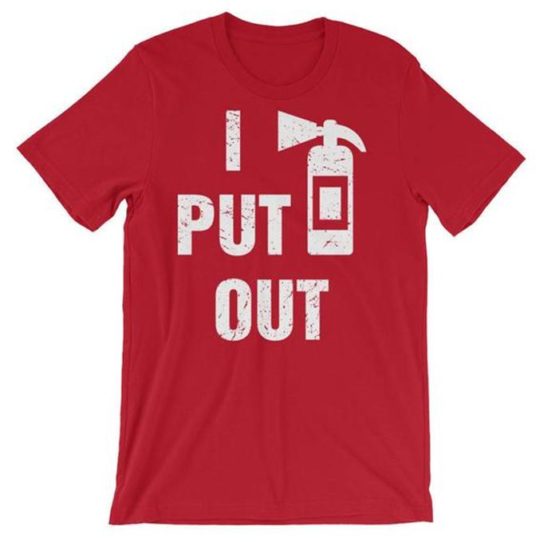 If only the ‘000’ Fire Brigade extinguisher standard applied outside metropolitan Australia?
If only the ‘000’ Fire Brigade extinguisher standard applied outside metropolitan Australia?
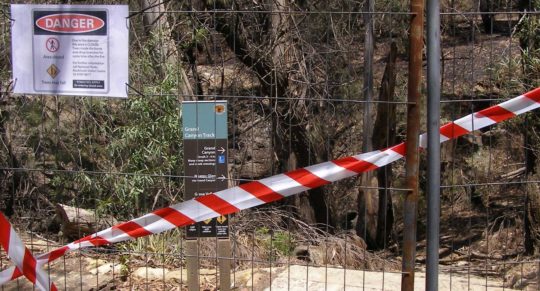 No longer enjoying the benefits of the tourism economy. The Grand Canyon Track closed since 30 November 2019 and still closed on 21 January 2020 -peak tourist season.
No longer enjoying the benefits of the tourism economy. The Grand Canyon Track closed since 30 November 2019 and still closed on 21 January 2020 -peak tourist season.
What had started as a small plume of smoke off Army Road on Saturday 26th October on a rural property near Gospers Mountain some sixty kilometres to the north, had been allowed to burn away into the World Heritage of the Wollemi National Park wilderness for weeks. It was allowed to destroy all the magnificent Wollemi wilderness from end to end.
By the time the bushfire had crossed to the southern side of the Bells Line of Road 50km south, the RFS changed their pet name of the ‘Gospers Mountain Fire’ to being dubbed the ‘Grose Valley Fir’e. Why not? That was the goal – defacto hazard reduction.
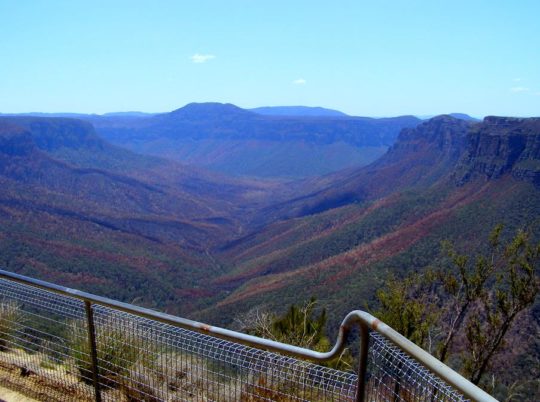 The iconic Blue Gum Forest in the Grose Valley of the Blue Mountains was left to incinerate by the New South Wales Government in December 2019. They did what Williamson in the 1920s failed to achieve. [Source: Editor, The Habitat Advocate, photo taken from Valley View Lookout 100m north of Evans Lookout, 20200121]
The iconic Blue Gum Forest in the Grose Valley of the Blue Mountains was left to incinerate by the New South Wales Government in December 2019. They did what Williamson in the 1920s failed to achieve. [Source: Editor, The Habitat Advocate, photo taken from Valley View Lookout 100m north of Evans Lookout, 20200121]
Once World Heritage values of the Grose Valley have now gone up in smoke. The icon Blue Gum Forest has been incinerated yet again since the previous RFS successful attempt in November 2006. No wonder the place is very very quiet. All the wildlife is dead and the native birds have flow away.
 Close up of the Blue Gum Forest from near Evans Lookout (top of photo) showing the canopy of Eucalyptus deanei incinerated; not much left of the forest in the foreground either. [Source: Editor, The Habitat Advocate, photo taken from Valley View Lookout 100m north of Evans Lookout, 20200121]
Close up of the Blue Gum Forest from near Evans Lookout (top of photo) showing the canopy of Eucalyptus deanei incinerated; not much left of the forest in the foreground either. [Source: Editor, The Habitat Advocate, photo taken from Valley View Lookout 100m north of Evans Lookout, 20200121]
This time they have succeeded in total incineration – their goal of converting hazardous forest ecology into anthropocentric manageable parkland has long been misunderstood by ideologically hopeful environmentalists. The misnomer National Parks and Wildlife Service (NSW) ethically should now do the right thing and re-brand itself State Parks Administration Service it commercially is.
More than 80% of the Blue Mountains World Heritage Area and more than 50% of the Gondwana world heritage rainforests of northern New South Wales and southern Queensland have been burnt in Australia’s worst bushfire disaster in history. The scale of the disaster is such that it could affect the diversity of eucalypts for which the Blue Mountains world heritage area is recognised, said John Merson, the executive director of the Blue Mountains World Heritage Institute.
The Habitat Advocate has written to UNESCO’s World Heritage Centre expressing shock, outrage and anger over government mismanagement and contempt for Blue Mountains ecology through abject neglect in bushfire response. With most of the world heritage incinerated, we have questioning the status of the Blue Mountains World Heritage Area as these values apply to Eucalypt diversity, since 80% has been incinerated.
UNESCO’s World Heritage Centre has expressed concern about the scale and intensity of bushfire damage to the Blue Mountains World Heritage Area and to the Gondwana Rainforests and has asked the Australian government whether it should de-list their world heritage status. In a statement on its website, UNESCO said members of the media and civil society had asked about the bushfires affecting the areas inscribed on the world heritage list as the “Gondwana rainforests of Australia”. The forests are considered a living link to the vegetation that covered the southern super-continent Gondwana before it broke up about 180m years ago.
According to UNESCO:
“The World Heritage Centre is currently verifying the information with the Australian authorities, in particular regarding the potential impact of the fires on the outstanding universal value of the property. The Centre has been closely following-up on this matter and stands ready to provide any technical assistance at the request of Australian authorities.”
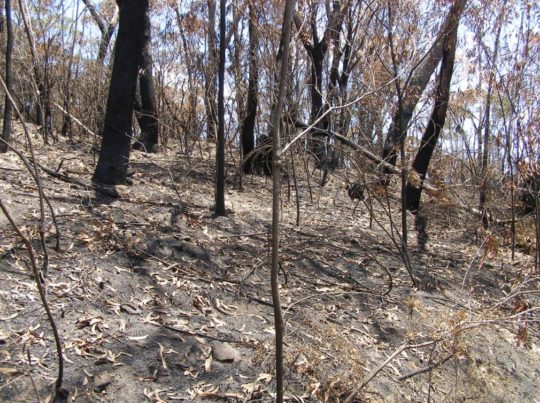 Blue Mountains World Heritage is a misnomer and a sick joke. This RFS blackened moonscape now blankets 80% of the Blue Mountains World Heritage Area. Incinerated, quite dead, quiet, subsequently oven baked in the scorching sun and now sterilised. The tamed moonscape is far easier to manage for the Parks Service, like Centennial Park. [Source: Editor, The Habitat Advocate, photo taken 20200121 of escarpment track near Evans Lookout.]
Blue Mountains World Heritage is a misnomer and a sick joke. This RFS blackened moonscape now blankets 80% of the Blue Mountains World Heritage Area. Incinerated, quite dead, quiet, subsequently oven baked in the scorching sun and now sterilised. The tamed moonscape is far easier to manage for the Parks Service, like Centennial Park. [Source: Editor, The Habitat Advocate, photo taken 20200121 of escarpment track near Evans Lookout.]
Further Reading:
[1] ‘Grose Wilderness‘, by historian Andy Macqueen, Blue Mountains Nature website, ^https://bmnature.info/conservation-wilderness-grose.shtml
[2] ‘Wild About Wilderness‘ in ‘The Ways of the Bushwalker’, 2007, a book by Melissa Harper, published by University of New South Wales Press Ltd, pp.258-259.
[3] ‘Burning Issues – Fire in the Grose Valley‘, 200612, by Ian Brown, Mount Victoria, ^http://www.abc.net.au/cm/lb/6276108/data/grose-fire-gazette-data.pdf
[4] ‘2006 Grose Fires: the realisation of a tragedy‘, 20120712, by Editor, The Habitat Advocate, >https://www.habitatadvocate.com.au/2006-grose-fires-the-realisation-of-a-tragedy/
[5] ‘2006 Grose Valley Fire – a cover up?‘, 20101217, by Editor, The Habitat Advocate, >https://www.habitatadvocate.com.au/2006-grose-valley-fire-a-cover-up/
[6] ‘Bushwalking and the Conservation Movement‘, in printed book ‘Blue Mountains – Pictorial Memories, 1998, by John Low AO, pp. 96-97, published by Kingsclear Books
[7] ‘2006 Grose Fire – Log of Media Releases‘, by Editor, The Habitat Advocate, >https://www.habitatadvocate.com.au/2006-grose-fire-log-of-media-releases/
[8] ‘The monster’: a short history of Australia’s biggest forest fire‘ (Gospers Mountain ‘mega fire’), 20191220, by Harriet Alexander and Nick Moir, Sydney Morning Herald newspaper, ^https://www.smh.com.au/national/nsw/the-monster-a-short-history-of-australia-s-biggest-forest-fire-20191218-p53l4y.html
[9] ‘It’s heart-wrenching’: 80% of Blue Mountains and 50% of Gondwana rainforests burn in bushfires‘, 20200116, by Lisa Cox and Nick Evershed, The Guardian newspaper, ^https://www.theguardian.com/environment/2020/jan/17/its-heart-wrenching-80-of-blue-mountains-and-50-of-gondwana-rainforests-burn-in-bushfires
[10] David Noble Blog, articles tag=Blue Gum Forest, ^http://www.david-noble.net/blog/?tag=blue-gum-forest
[11] ‘Lessons from the 1957 Leura Bushfire‘, 20190912, The Australian Bushfire Building Conference website, ^https://bushfireconference.com.au/news/the-1957-leura-bushfire/. Also check: ^http://www.fire.bmwhi.org.au/
All they had to do was to put the small plume out when it started, like the proper fire brigade does in metropolitan Australia.
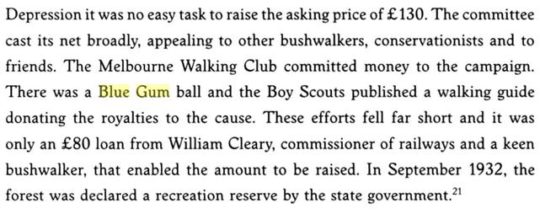
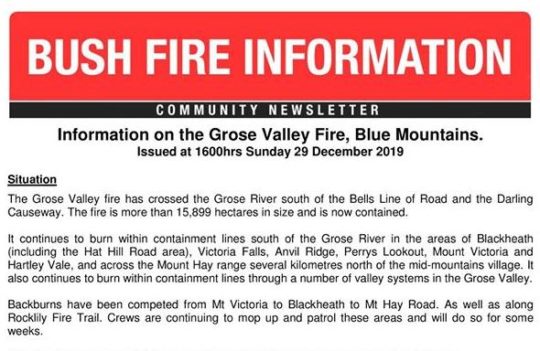

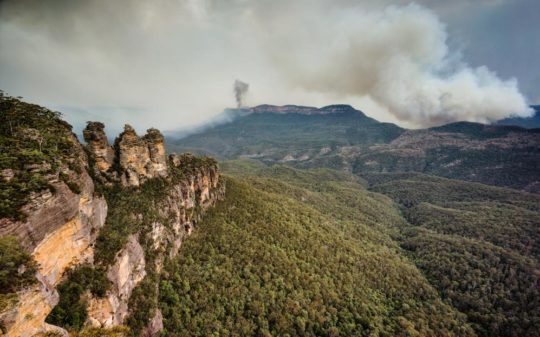 Welcome to the Blue Mountains World Heritage Area. Won’t you enjoy your stay?
Welcome to the Blue Mountains World Heritage Area. Won’t you enjoy your stay?
